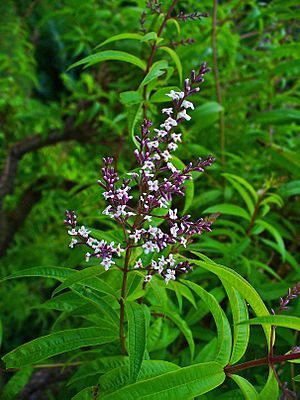Aloysia citrodora facts for kids
Quick facts for kids Aloysia citrodora |
|
|---|---|
 |
|
| Scientific classification | |
| Genus: |
Aloysia
|
| Species: |
citrodora
|
| Synonyms | |
|
Aloysia triphylla (L'Hér.) Britton |
|
Aloysia citrodora, also known as lemon verbena, is a type of flowering plant. It belongs to the verbena family called Verbenaceae. This plant originally comes from South America. Another common name for it is lemon beebrush. People brought lemon verbena to Europe in the 1600s. They grew it for its special oil.
Contents
About Lemon Verbena
Lemon verbena is a perennial shrub. This means it lives for more than two years and has woody stems. It can grow to be about 2 to 3 meters (6.5 to 10 feet) tall. Its leaves are shiny and pointed, about 8 cm (3 inches) long. They feel a bit rough. If you gently crush the leaves, they release a strong lemon smell. This is why its scientific name, citrodora, means "lemon-scented."
Small purple or white flowers appear on the plant in late spring or early summer. If you grow lemon verbena in a pot, it might not flower. In warm, tropical places, the plant stays green all year. But it doesn't like cold weather. Its leaves fall off if the temperature drops below 0 °C (32 °F). However, the woody parts of the plant can survive colder temperatures down to −10 °C (14 °F). It's a good idea to trim the plant in spring. This helps it grow into a nice, bushy shape. Because it has many uses in cooking, you can often find it sold as a plant for an herb garden.
How People Use Lemon Verbena

Lemon verbena leaves are great for adding a lemon taste to food. You can use them with fish and poultry (like chicken). They are also good in vegetable marinades, salad dressings, and jams. Some people add them to puddings and Greek yogurt. The leaves are also used to make drinks.
Many people use lemon verbena to make herbal teas. It can also flavor liqueurs. In Latin American countries, it has been used in traditional medicine for a long time. In the past, people would get oil from the leaves using steam. This oil was used in the perfume industry. However, this oil can sometimes bother the skin or make it sensitive to sunlight. Because of this, verbena essential oil is no longer allowed as a fragrance ingredient in the European Union.
What's Inside Lemon Verbena?
The main natural chemicals found in lemon verbena oil are citral, nerol, and geraniol. These are what give it its special smell. Lemon verbena also contains other plant chemicals. The US Food and Drug Administration (FDA) generally says that lemon verbena oil is safe to use as a flavoring in food.
Other Names for Lemon Verbena
Lemon verbena has a few other scientific names. These include Verbena triphylla L'Hér., Verbena citriodora Cav., Lippia triphylla, and Lippia citriodora.
History in Gardens
The first European scientist to write about lemon verbena was Philibert Commerson from France. He found it in Buenos Aires around 1767. This was during his plant-collecting trip around the world. The plant was also brought directly to the Real Jardín Botánico de Madrid (Royal Botanical Garden of Madrid) in Spain.
In 1797, professors there named it Aloysia citriodora in Latin. They also called it "Hierba de la Princesa" in Spanish. This was to honor Maria Louisa of Parma, who was the Princess of Asturias. The name was officially published in a book in 1784.
Later, another French botanist named Joseph Dombey brought plants from Lima to Spain in 1785. Sadly, most of his plants were lost. But lemon verbena was one of the few that survived. Seeds and samples of the plant were sent to Charles Louis L'Héritier de Brutelle in Paris. He published its name as Verbena triphylla in his book in 1785 or 1786.
From Paris, John Sibthorp, a botany professor from Oxford, got a sample. He brought it to British gardens. By 1797, lemon verbena was common in greenhouses around London. It became very popular for its lovely scent in flower arrangements throughout the next century.
This plant has won an important award called the Royal Horticultural Society's Award of Garden Merit.
See also
 In Spanish: Cedrón para niños
In Spanish: Cedrón para niños

